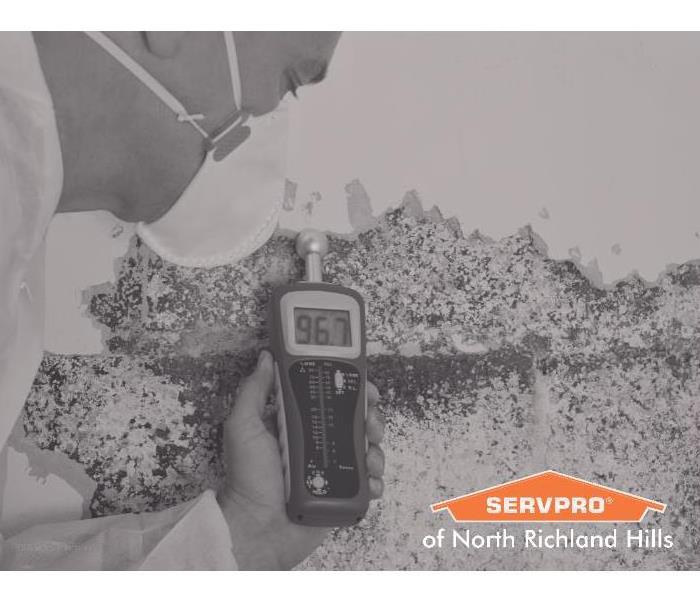How to Get Rid of Mold Mites
10/16/2020 (Permalink)
How many living things are inside your house? Of course, you count your family and your pets, but microorganisms and sometimes pests find their way inside to share the dwelling.
As the expert mold fighters in Fort Worth, Texas, SERVPRO has a thorough understanding of how mold behaves. Here are a few facts about mold:
- What mold eats: Mold likes to hang around in a building or house because of the abundance of cellulose materials it can consume like drywall, paper, fabrics, carpet, wood, etc.
- What eats mold: Mold is a part of a grand life cycle. Mold consumes matter, and in turn, other living things consume mold like fungus gnats, booklice, and mold mites. Slugs, roaches, camel crickets, and millipedes are attracted to mold because they want the organic matter that mold breaks down.
So several creatures use mold as a food source, but today we’ll focus on mold mites. When you remove mold colonies from your home, you are likely to remove numerous mold mites that gather to feast on it.
What Are Mold Mites?
The formal name for mold mites is tyophagus putescentiae. Other names for these tiny critters are cheese mites, “putrid cheese eater,” meat mites, flour mites, or computer mites. While they resemble insects, they are not. Mold mites are arthropods and are related to ticks.
Mold mites are hairy and white or tan in color. They are very hard to see as they are no larger than a crumb. Speaking of small bits, thousands of mold mites will congregate on a very small piece of mold. When they cluster together, it’s easier to spot them. If you spot mold, chances are there are mold mites present.
How to Identify Mold Mite Bites
Something bit you. Was it a mold mite? If a mite bit you, it was more likely a chigger than a mold mite. Mold mites do not bite humans, but you might end up with a rash, or red bumps from them (that could be mistaken for mold mite bite). Their long hairs irritate the skin of those who are allergy-prone and may feel like a bite.
If you spend enough time in a mold-infested environment, you may end up with some stinging and itching from mold mites. This is an adverse reaction rather than a bite.
How to Get Rid of Mold Mites
Mold mites rarely come into contact with humans or bother them, but even so, many homeowners are bothered by any insect-like creature being indoors.
Mold and bugs both thrive in warm, humid areas. Moisture finds its way into your home in many different ways such as faulty roofs, leaky pipes, unventilated bathrooms, spills, drafts, or through the crawlspace. Mold needs a relative humidity of 70 percent or higher at temperatures below 60 degrees to flourish.
Like any pest, the most effective mold mite treatment is to take away what brought them inside in the first place - mold. By taking away their food source, mold mites won’t have a reason to come back. Stop attracting mold mites with the prevention tips below.
- Remove or clean mold-infested items in all areas of your home.
- Open your windows to let some light and fresh air in. Ventilation and sunlight inhibit mold growth.
- Purge your pantry and fridge of expired food.
- Wipe down surfaces with hot water and soap. Make sure to dry surfaces thoroughly. Follow up with a disinfectant and go by the instruction label exactly. Some products must sit for a while before being wiped away.
- Pull excess moisture from the air by using a dehumidifier.
- Remove any dead or dying plants in or around your home. Remember, mold is a natural decomposer, so dying organic material is a prime target.
How to get rid of mold mites in your house is as simple as removing their food source so they stick to finding sources of mold out in nature instead.
Flooding and Mold Mites
If a home or building doesn’t have a mold problem already, a water emergency (such as flooding) creates an opportunity for mold to take root. Mold will start to grow in a flood-affected structure within 24-48 hours of the incident.
As we said earlier, measures taken to eliminate mold remove the conditions that invite mold mites to move in. The best way to avoid toxic mold growth is to do a complete and thorough water damage cleanup.
The more extensive the water damage and saturation, the more likely it is that you’ll need professional water damage recovery services. If you’re in the middle of a water emergency mess and you’re not sure what to do, call us at SERVPRO. We’ll answer your questions on how to proceed, and we’ll even do a free consultation.
Professional Cleaning Services & Mold Removal in Fort Worth
SERVPRO of North Richland Hills is not a pest control service, but we can remove the mold that attracted these mites in the first place. We offer complete water damage restoration to prevent mold growth, or a thorough mold remediation if mold is discovered. With our technicians donning the proper personal protective equipment we can get close to the mold so you don’t have to.
SERVPRO is a trusted brand in professional cleaning for Fort Worth properties. We have advanced equipment, industrial-grade cleaners, and the best technician training in the industry. When you encounter water damage, or you suspect there may be mold, call us at (817) 589-1499 for a complimentary quote!




 24/7 Emergency Service
24/7 Emergency Service
